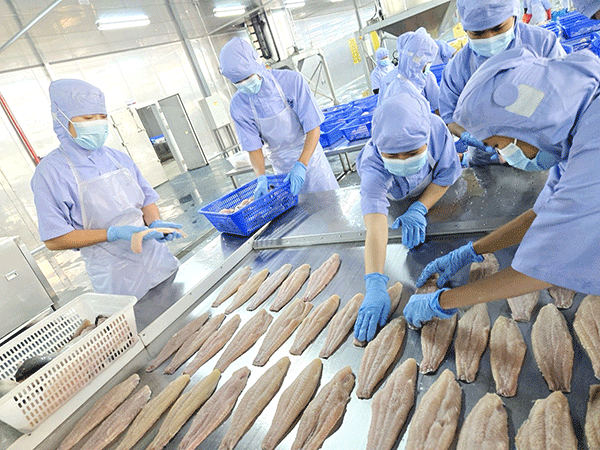 |
| Workers sort and inspect pangasius fillets at a processing plant in preparation for export. |
Laos sends first shipment of pangasius fish to China
Lao-raised freshwater pangasius fish have been exported to China for the first time, marking a major breakthrough in fisheries trade under the Belt and Road Initiative.
The aquatic species, farmed and processed in Laos, entered China for the first time after passing customs inspections in Shenzhen on March 31, according to Lao National Radio
The shipment consisted of high-quality pangasius fish raised and processed at the Mekong River Pangasius Industrial Park in Khong district, Champassak province.
The fish cleared customs at Shekou Port in Shenzhen City, Guangdong province, and have now reached Chinese consumers, marking a historic step in Laos-China fisheries trade.
This is the first time that aquatic products from Laos have entered the Chinese market directly, after three years of development under a joint project supported by the Belt and Road Initiative.
The project is led by the Shenzhen Zhongyu Marine Technology Company, with strong backing from the Development and Reform Commission of Shenzhen Municipality.
In December 2024, the governments of Laos and China signed an agreement on inspection and quarantine requirements for aquatic products exported to China. Soon after, the General Administration of Customs of China announced that Laos had been granted market access.
The Mekong Fishery Pangasius Industrial Park in Laos covers 2,863 hectares, making it the first and largest of its kind in the country.
In 2024, the first phase of the park began operations with an expected annual output of about 20,000 tonnes of pangasius, and a processing capacity of 12,000 tonnes per year. This is valued at about 330 million yuan, or over 963 billion kip.
Once fully completed, the park is expected to process more than 500,000 tonnes of pangasius annually, creating a major export industry for Laos and helping to ensure fish supply for the Chinese market.
The project has received strong support from the Lao Ministry of Agriculture and Forestry, through the Department of Livestock and Fisheries, and has been welcomed by government leaders.
Before this development, Laos had no large-scale aquaculture system or direct trade channel for aquatic products with China. The project has changed that by creating a systematic supply chain from fish farming to export.
The fish contained in the first shipment came from a newly built aquatic processing plant inside the industrial park, which has been authorised to sell fish to China and operates using modern food safety and quality systems.
The successful delivery of Lao fish to Shenzhen is seen as a model of global fisheries cooperation and trade, supporting the sustainable use of natural resources and offering a new path for cross-border aquaculture development.
By Times Reporters
(Latest Update April 9, 2025)
|


